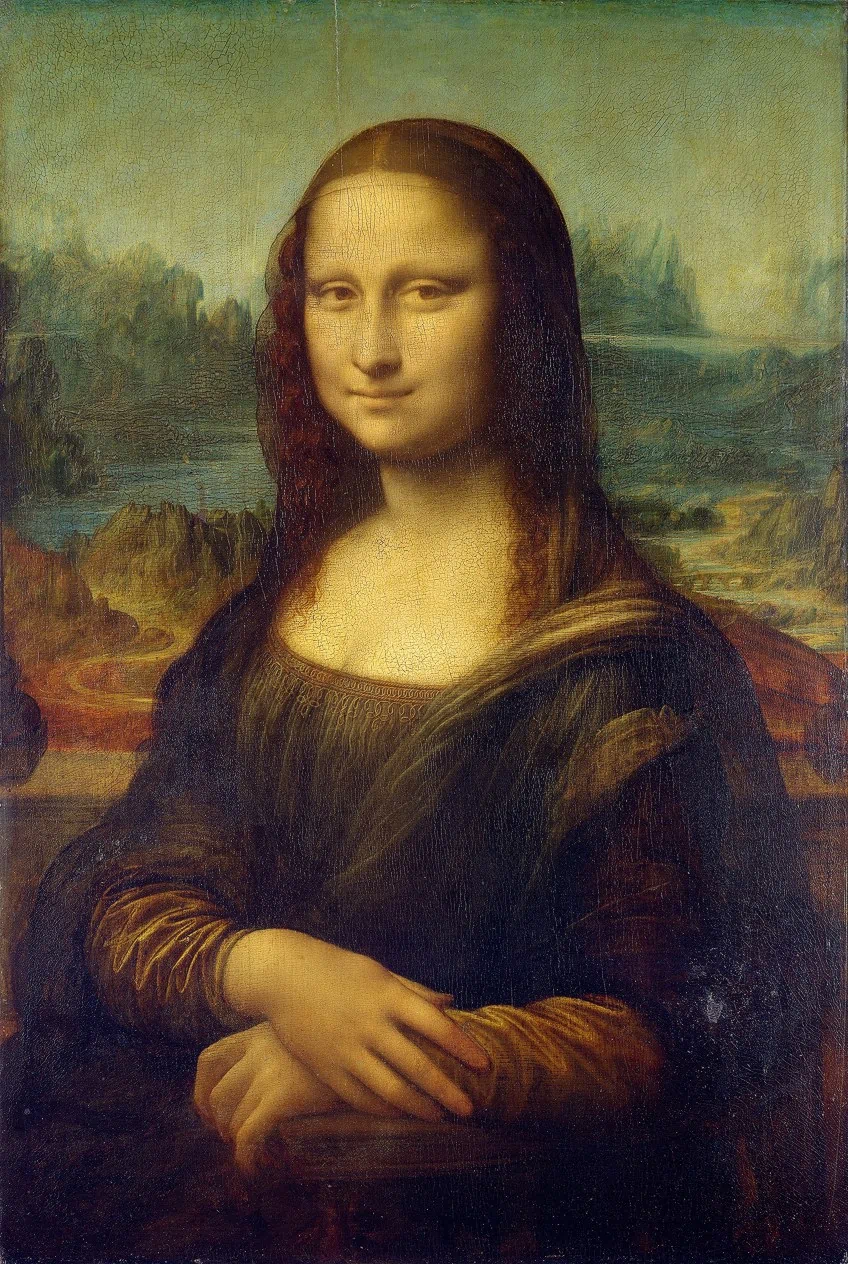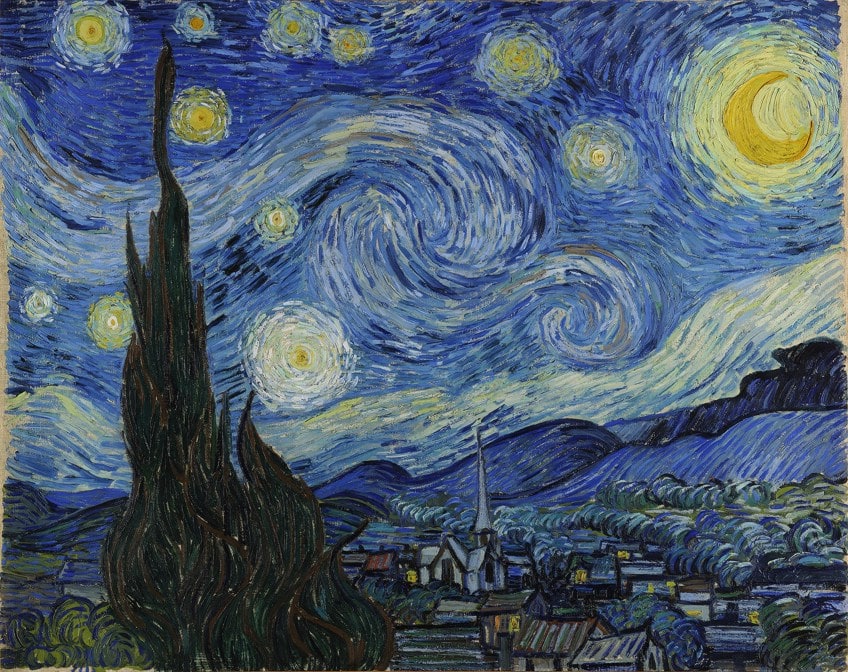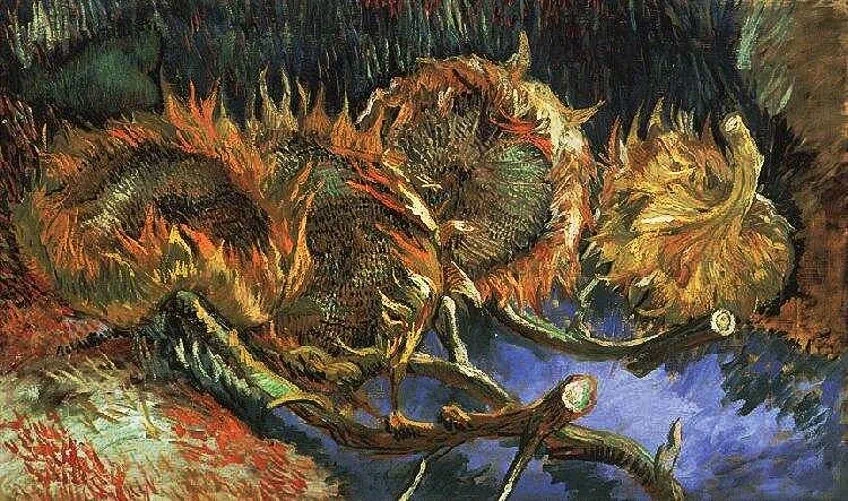Texture in Art – A Look at the Importance of Texture in Painting
The human sense of touch is one of the most important assets for experiencing the world around us. This sense can also be evoked in art via the illusion of visual texture. Texture in art can be executed in multiple ways and significantly adds to the experience of a subject. This article will help you understand texture in art through various texture art examples, as well as texture as one of the basic elements of art.
Contents
- 1 Texture in Art
- 2 Texture Art Examples
- 2.1 Sunflowers (1887) by Vincent van Gogh
- 2.2 The Garden with Flowers (1888) by Vincent van Gogh
- 2.3 Descending (1966) by Bridget Riley
- 2.4 Cruz y Tierra (1975) by Antonio Tàpies
- 2.5 Für Andrea Emo (1978 – 2017) by Anselm Kiefer
- 2.6 Balloon Dog Series (1994 – 2000) by Jeff Koons
- 2.7 Dusasa II (2007) by El Anatsui
- 2.8 Cfaal 346 (2013) by Jessica Eaton
- 3 Frequently Asked Questions
Texture in Art
Texture in art refers to the visual mimicry of the physical sensation of an object, material, or subject. This can be seen (and felt) in texture artwork that emphasizes the materiality of the subject to enhance the experience of the viewer and bring the artwork to life.
Texture in art can also be achieved in a variety of ways in connection with the other elements of art.

It is important to understand that when employing texture as a key component in your artwork, you also take note of the principles of art, which can be used to organize texture (as an art element). Texture, as found in artworks that rely on principles of art such as emphasis, variety, and contrast, can be used to reiterate the intention of the artwork and build on its meaning. To refresh your memory, the elements of art encompass line, form, shape, color, space, value, and texture. Below, you will find a summary table of the basic elements of art.
| Art Element | Definition |
| Line in art | Line refers to the path created between two points. Lines vary in shape, length, and width. |
| Shape in art | Shape is characterized by its confines, which are limited to height and width. Shape can be used to create both two-dimensional and three-dimensional objects. |
| Color in art | Color is defined by three defining attributes: hue, value, and intensity (chroma). |
| Form in art | Form is made up of height, width, and depth with an enclosed volume and two-dimensional aspects that render a three-dimensional object. |
| Texture in art | Texture refers to the tactile sensation of an artwork evoked by a visual stimulus that mimics the surface of an object. |
| Space in art | Space is made up of negative and positive space. Space is also the relationship between the main subject of an artwork and the artwork as a whole. |
| Value in art | Value is defined as the darkness and lightness of hue. Value also carries other meanings across economic, social, political, and artistic contexts. |
Texture Art Definition
Texture as an art element solely speaks to the feeling or sensation evoked by the medium of the artwork and alludes to the mimicry of surfaces in an artwork. Texture art is a genre of art that makes use of the tactile experience and texture as an art element as the focal point of the artwork.
Texture art employs various mediums, often textile and mediums that produce a sense of three-dimensionality, to fully express a gesture through sculpture, painting, installation, and at the two-dimensional level, in drawing and photography.

To elaborate on the texture art definition, one can say that texture art is also descriptive. If you have ever used words such as “rough”, “grainy”, or “fluffy” to describe a textured artwork, then you have already formed a visual-tactile definition of texture art.
Different Types of Texture in Art
Texture in art is visually represented in different ways. This includes texture in painting, sculpture, architecture, and photography. While we can acknowledge the elephant in the room is that one cannot physically touch an artwork, you can gain an appreciation of texture through different artworks and their varied applications.
Texture in artwork has the potential to influence the way an artwork is seen and valued.
Texture can also be found in works that do not necessarily portray a three-dimensional object but the idea of flatness. Flat textures, as seen in works by Kenneth Noland and Kazimir Malevich, offer another perception of texture. Be it flat or rugged, texture varies. Below, you will find some of the different types of textures in art.
Implied Textures
These textures are created through the manipulation of mediums to imitate a particular texture. This means that the visual you are presented with is not the actual material used for that particular texture but it is a visual mimicry.

Actual Textures
Actual texture refers to the actual surface of the object and is often easily described as the immediate tactile sensation. This is also known as genuine texture, as it is the real-life texture of an object. Actual textures are also referred to as surface textures.

Abstract Textures
An abstract texture is a visual representation of an object or subject that is real enough for the viewer to identify while remaining unrealistic. This means that a marking can allude to the texture of something without it displaying a direct visual quality of the intended texture or object.

Simulated Textures
These textures are characterized by appearance versus reality. This means that the appearance of the texture is usually different from what it feels like. Below, we will look at a few texture art examples illustrating the different types of texture in art.

Texture Art Examples
The other elements of art (line, color, shape, value, space, form) can also be used to illustrate texture. Below, we have listed a few examples of artworks that illustrate texture in different ways while incorporating other art elements.
Sunflowers (1887) by Vincent van Gogh
| Artist Name | Vincent van Gogh (1853 – 1890) |
| Date | 1887 |
| Medium | Oil on canvas |
| Dimensions (cm) | 60 x 100 |
| Where It Is Housed | Kröller-Müller Museum, Otterlo, Netherlands |
Van Gogh’s artwork is also useful for examining texture in painting. In most of his artworks, Van Gogh created texture through his use of the impasto painting technique coupled with his use of line in his oil paintings. An example of texture in paintings by Van Gogh includes his still life painting Sunflowers (1887), showing dried sunflowers.
In this painting, Van Gogh makes use of the art elements of color and value to illustrate the dry sunflowers, which appear intentionally cut off.

The Garden with Flowers (1888) by Vincent van Gogh
| Artist Name | Vincent van Gogh (1853 – 1890) |
| Date | 1888 |
| Medium | Ink on paper |
| Dimensions (cm) | 61 x 49 |
| Where It Is Housed | Private collection |
Texture in art is still present in two-dimensional pieces such as The Garden with Flowers (1888). Here, the art element, line, is used to give the viewer a visual representation of the texture of the plants in the garden through a combination of short and medium straight lines to illustrate the vegetation swaying in the wind and give us a sense of the texture of the plants.
Lines used in drawing and etching to illustrate otherwise two-dimensional images can be used to bring a three-dimensional quality to the surface of the subject and thus present texture.

Texture in elements of art such as color, shape, value, and form can also be achieved. This can be accomplished via color through the use of the art principle, gradation, to achieve a texture of smoothness and depth. Color can also be used to highlight lines, which contributes to enhancing texture and adds to the dimensionality of the artwork.
You will notice that it often requires a combination of art elements with principles to create texture, form, and three-dimensionality.
Descending (1966) by Bridget Riley
| Artist Name | Bridget Riley |
| Date | 1966 |
| Medium | Emulsion on board |
| Dimensions (cm) | 91.5 x 91.5 |
| Where It Is Housed | Sprüth Magers, Los Angeles |
Texture is also found in optical illusion art pieces such as Descending (1966) by Bridget Riley, who creates the illusion of waves through the use of lines. These lines contribute to the viewer’s overall perception of the artwork as a multi-dimensional piece.
Instead of using physical materials for texture, one can also employ the art of optical illusion to create a visual texture of dimension.

Cruz y Tierra (1975) by Antonio Tàpies
| Artist Name | Antonio Tàpies (1923 – 2012) |
| Date | 1975 |
| Medium | Mixed media |
| Dimensions (cm) | Unavailable |
| Where It Is Housed | Unavailable |
Another great example of how texture is incorporated into art is Cruz y Tierra (1975) by global contemporary artist Antonio Tàpies. Here Tàpies makes use of sandy, grainy textures by including the actual material in his work. There is no other material that is better at creating this sandy texture than sand itself.
Many environmental artists also introduce texture in sculpture by incorporating the natural environment into their works.
Für Andrea Emo (1978 – 2017) by Anselm Kiefer
| Artist Name | Anselm Kiefer (1945 – Present) |
| Date | 1978 – 2017 |
| Medium | Emulsion, acrylic, oil, shellac, plaster, lead, charcoal canvas |
| Dimensions (cm) | 160 x 103 x 20 |
| Where It Is Housed | White Cube gallery |
Textured abstract art can also be seen in the works of German artist, Anselm Kiefer who is famous for using materials such as shellac, ash, clay, and lead in his sculptural pieces. für Andrea Emo (1978–2017) is one such example where the work appears deteriorated and gives off the sensation that it has been burnt into. Kiefer’s process of creating textured abstract art involved the use of acid or lead used to burn into artworks.
Many of his works also refer to funeral sculpture, Nazi architecture, the Black Forest, and other references that carry this aesthetic.
Balloon Dog Series (1994 – 2000) by Jeff Koons
| Artist Name | Jeff Koons (1955 – Present) |
| Date | 1994 – 2001 |
| Medium | Chromium stainless steel with transparent color coating |
| Dimensions (cm) | 307.3 x 363.2 x 114.3 |
| Where It Is Housed | Metropolitan Museum of Art, New York |
Jeff Koons provides an excellent example of surface texture in art through his series Balloon Dog (1994 – 2000) where he produced numerous sculptures and paintings. The Balloon Dog seen above is a large-scale sculpture constructed out of chromium steel to mimic the appearance of a balloon surface, which is smooth and carries a latex quality.
Koons makes a sculpture appear to be as light as a balloon while using a material such as steel that is the complete opposite.
Texture in sculpture is accompanied by a three-dimensional quality. Like Koons’ Balloon Dog sculptures, texture is not only found in the three-dimensional body of an artwork but is also created through further development on the surface.
Further refinement of an artwork, such as buffing a surface, engraving a pattern, gauging out pieces of clay, or adding on decorative elements also creates texture and enhances the experience of the artwork.
Dusasa II (2007) by El Anatsui
| Artist Name | El Anatsui (1944 – Present) |
| Date | 2007 |
| Medium | Found aluminum, copper wire, and plastic discs |
| Dimensions (cm) | 599.4 x 731.5 x 5.1 |
| Where It Is Housed | Metropolitan Museum of Art |
Another example of textured abstract art is found in the work of Ghanian-born artist, El Anatsui. Anatsui repurposes old alcohol bottle caps to create these magnificent large-scale sculptural sheets, which bear a textile quality. According to Anatsui, as quoted in The Nomadic Aesthetic, he takes an interest in textile because it is something that is “always in motion” and the sheet carries the idea that “you can shape and reshape”. It is something that can lie on the floor or ceiling and all the fluidity that it brings is part of his concept.
The folds in Anatsui’s work are also part of the additive element that creates the visual texture of a textile sheet.
Cfaal 346 (2013) by Jessica Eaton
| Artist Name | Jessica Eaton (1977 – Present) |
| Date | 2013 |
| Medium | Inkjet print |
| Dimensions (cm) | 127 x 101.5 |
| Where It Is Housed | National Gallery of Canada, Ottawa |
As you may perceive, aside from texture born out of physical materiality, there is also texture that originates from the perception of materiality. As we have observed in the optical illusion-based work by Bridget Riley, Canadian photographer Jessica Eaton also builds on evoking the perception of texture through her manipulation of light, color, and photography tools.
This incredible artwork can be admired for its process, which makes use of in-camera production, multiple exposure, masking, and filters.
By constructing a three-dimensional artwork through the use of photography, Eaton expands our belief of what can be achieved with the camera as an artistic tool and implores all viewers to test the boundaries of creating texture.
If not for Eaton’s unique process behind these colorful prints, one can also speculate that there is a texture to light at play in Cfaal 346 (2013).
You may not think that light could carry texture but our immediate perception of light, portrayed visually, follows the trope of smooth, angular, and light in color. Eaton uses wooden cubes as the subject of her works, from which she then applies additive color mixing in her process to achieve the color in her work.
Texture as an art element is commonly associated with the physicality and materiality of things that can be “felt”. Texture in art offers you a broader perception, introducing you to the perception of texture and the different ways one can “see” and “feel” texture in an artwork. We hope that this article has helped you gain a deeper understanding of texture as an art element and how it can be viewed and interpreted in relation to the various mediums in art.
Take a look at our textures in art webstory here!
Frequently Asked Questions
What Is Texture?
Texture refers to the art element that is defined by the human sense of touch, specifically referring to what can be felt and visually perceived. It is the physical feeling of a surface or material. Texture can be found, created, and perceived.
What Is the Importance of Texture in Art?
Texture in art is important because it enhances the experience of the viewer, the interpretation of the subject matter, and the intention of the artwork. It helps evoke a tactile sensation through visual elements. Texture gives an artwork character and a sense of three-dimensionality.
What Are the Different Types of Textures in Art?
The different types of textures found in art range from surface textures, brought about by the outer layer of an artwork or sculpture, to simulated textures, implied textures, actual textures, and abstract textures.
Jordan Anthony is a Cape Town-based film photographer, curator, and arts writer. She holds a Bachelor of Art in Fine Arts from the University of the Witwatersrand, Johannesburg, where she explored themes like healing, identity, dreams, and intuitive creation in her Contemporary art practice. Jordan has collaborated with various local art institutions, including the KZNSA Gallery in Durban, the Turbine Art Fair, and the Wits Art Museum. Her photography focuses on abstract color manipulations, portraiture, candid shots, and urban landscapes. She’s intrigued by philosophy, memory, and esotericism, drawing inspiration from Surrealism, Fluxus, and ancient civilizations, as well as childhood influences and found objects. Jordan is working for artfilemagazine since 2022 and writes blog posts about art history and photography.
Learn more about Jordan Anthony and about us.
Cite this Article
Jordan, Anthony, “Texture in Art – A Look at the Importance of Texture in Painting.” artfilemagazine – Your Online Art Source. August 24, 2022. URL: https://artfilemagazine.com/texture-in-art/
Anthony, J. (2022, 24 August). Texture in Art – A Look at the Importance of Texture in Painting. artfilemagazine – Your Online Art Source. https://artfilemagazine.com/texture-in-art/
Anthony, Jordan. “Texture in Art – A Look at the Importance of Texture in Painting.” artfilemagazine – Your Online Art Source, August 24, 2022. https://artfilemagazine.com/texture-in-art/.



